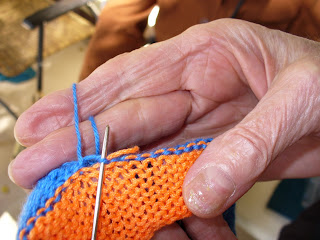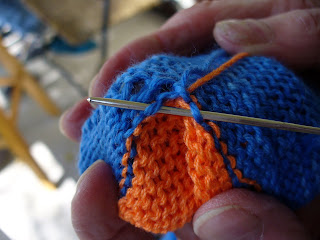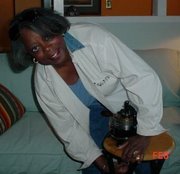

. . . Soon you won't.
I'm working with my 80/40 setup on the NZAK. The yarns are Opal (denim) and Soxx (dark red). I'm getting 9 rounds to the inch. The second Opal sock had issues. I remove all the needles when making a heel on a ribbed sock. Something went haywire when I finished the heel and added back the instep needles. I put the instep needles in the wrong slots. What was I thinking?!!! I tried to salvage the sock. I really did. It went from bad to worse and I finally threw in the towel and cranked the whole mess off to start over.
The Soxx sock has size issues. For some reason the foot came out much longer than I planned. I've been procrastinating trying to decide whether to duplicate it and have a gigantic pair or rewind and start all over. I'd just like to get a pair of ribbed socks in the size I'm aiming for from the 80/40 setup before moving on. Starting over seems to be the thing to do because I made a slight adjustment to the NZAK forgetting that I had another red sock to make.
The Soxx sock has size issues. For some reason the foot came out much longer than I planned. I've been procrastinating trying to decide whether to duplicate it and have a gigantic pair or rewind and start all over. I'd just like to get a pair of ribbed socks in the size I'm aiming for from the 80/40 setup before moving on. Starting over seems to be the thing to do because I made a slight adjustment to the NZAK forgetting that I had another red sock to make.
The pigtail came off my NZAK. That's the little coiled wire on the yarn carrier that the yarn is fed through. I jerry-rigged, in McGiver fashion, a bit of copper wire to hold the yarn down and guide it through the carrier. That's what I've been using. That is, until last Friday. In preparation for attending a MARS meeting, I finally cold welded (JB Weld) the pigtail back on so I could take my NZAK out in public in factory condition. As it turned out I couldn't attend the meeting (Real life got in the way.) and now my machine is just a hair different than when I made the first red sock. I will not even try getting a second sock to match. It has been my sock machine knitting experience that the least change on any machine makes a difference that I don't want to deal with.
I have not gotten my NZAK cranking out socks to my satisfaction. I have not been able to devote the time I need to jump over the learning curve I suppose. Using the 60/30 setup I made a few pairs of socks for myself that I was very happy with using KnitPicks Essential. I finally have some black socks! But not without some pain and suffering! It took a while to get used to the needle lifter (which I haven't even used yet) being there. It gets in my way. But at least I now know when that happens. I have a hard time with the heels. Once past the decreases, that first wrap starting the increases on each side is a doozie!
I was hoping to be an expert on the 60/30 compound by now. I have little socks to make! I've gotta get with it!!! Oh well, tomorrow is also a day.
I have not gotten my NZAK cranking out socks to my satisfaction. I have not been able to devote the time I need to jump over the learning curve I suppose. Using the 60/30 setup I made a few pairs of socks for myself that I was very happy with using KnitPicks Essential. I finally have some black socks! But not without some pain and suffering! It took a while to get used to the needle lifter (which I haven't even used yet) being there. It gets in my way. But at least I now know when that happens. I have a hard time with the heels. Once past the decreases, that first wrap starting the increases on each side is a doozie!
I was hoping to be an expert on the 60/30 compound by now. I have little socks to make! I've gotta get with it!!! Oh well, tomorrow is also a day.
The Sock Lady
 She was right! It is really easy from the purl side. No more first picking up on needles for me. After a few months of not closing any toes I had a refresher in October. I took pictures of Mary's hands this time. It was that first stitch that threw me.
She was right! It is really easy from the purl side. No more first picking up on needles for me. After a few months of not closing any toes I had a refresher in October. I took pictures of Mary's hands this time. It was that first stitch that threw me.

